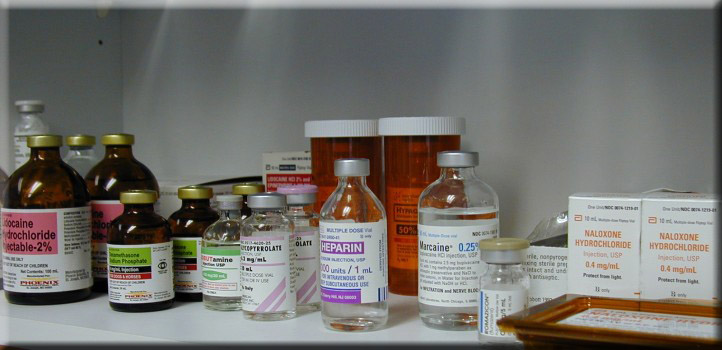 |
Veterinary Anesthesia & Analgesia Support Group |
| Practical Information for the Compassionate Veterinary Practitioner |
|
| HOME |
 |
||
|
|
||
| Alphabetical Drug Summaries | ||
| Dr. Bob Stein | ||
1) ISOFLURANE
a) Classification
i) Fluorinated hydrocarbon b) General Information
i) Considered one of the safest common inhalant agent for patients and staff ii) Its low solubility provided for quick inductions, level adjustments, and recoveries iii) MAC (1) Dog - 1.2% (2) Cats - 1.5% c) Advantages/Recommended use
i) 2nd most rapid inductions and recoveries of common inhalants ii) Does not sensitize the heart to epinephrine induced arrhythmia iii) Along with sevoflurane, an inhalant anesthetic of choice for patients with: (1) Liver disease (a) Minimal hepatic metabolism (2) Intracranial disease (a) Less effect on CSF pressure when compared to Halothane (b) Maintain ETCO2 at 20 - 30 mm Hg to minimize increases in CSF pressure d) Cautionary Information
i) Commonly causes respiratory depression ii) At higher levels (esp. > 2 x MAC) can be potent cardiac depressant and vasodilator iii) Can cause some increased CSF pressure e) Dosage Information
i) Routine use (1) Mask Induction (not recommended for routine use) (a) Start with 100% oxygen @ 3 liters/min for 3 - 5 minutes (b) Do not cover patients eyes (c) After 3 - 5 minutes of O2, start isoflurane @ 0.5 % (d) Increase by 0.5 % every 30 - 60 seconds until 2 % is reached (e) Then increase to 3.5 % - 5 % to complete induction (2) Induction following injectable agent (a) Initiate flow rates of 1.0 to 1.5 liter per minute at 3.0 % - 5.0 % (i) Reduce percentage as indicated by patients response (3) Maintenance – Moderately low flow use (a) Once stable, reduce oxygen flow to 500 ml to 1 liter (i) The reservoir bag must remain reasonably full
1. If not, the flow rate must be increased and the machine must be examined for leaks at the earliest possible convenience (b) Remember that prior to surgical stimulation, a patient may appear adequately anesthetized only to show a dramatic response to stimulation (i) An experienced anesthetist should be able to anticipate and minimize this event (ii) Effective analgesic & sedative premeds will significantly reduce the level of inhalant agent necessary for maintenance of a surgical plane of anesthesia f) Cost
i) Moderately low |
||
| Return to top of page | ||
| Questions or problems regarding this web site should be directed to DRSTEIN@VASG.ORG . Copyright © 2003 ASAH. All rights reserved. Last modified: February 16, 2011 . |
||